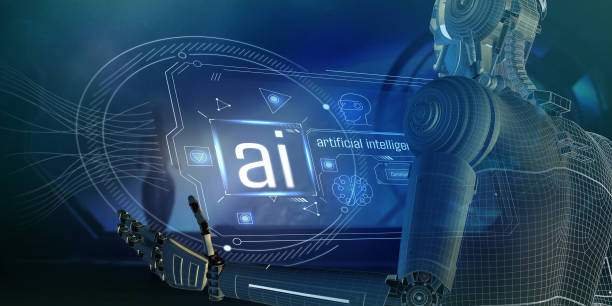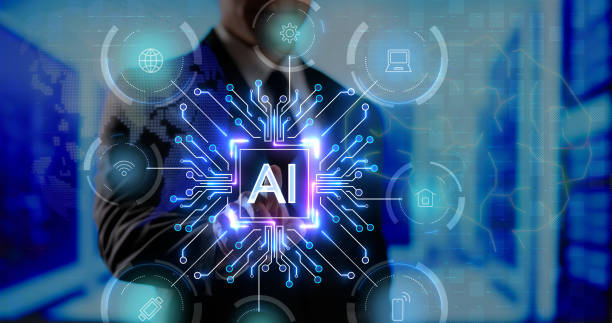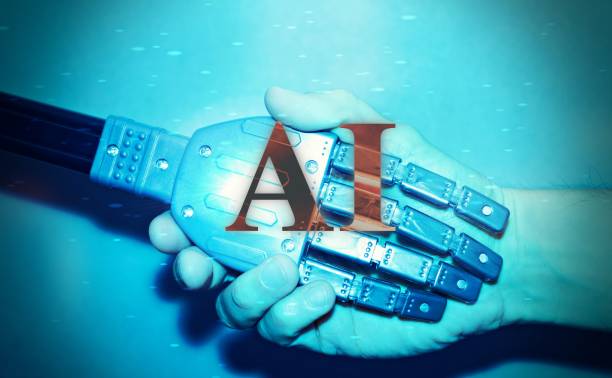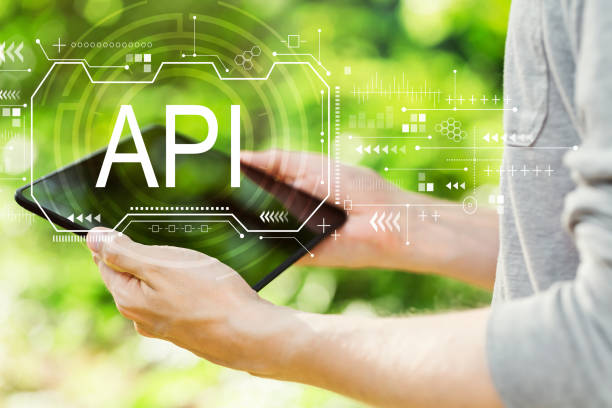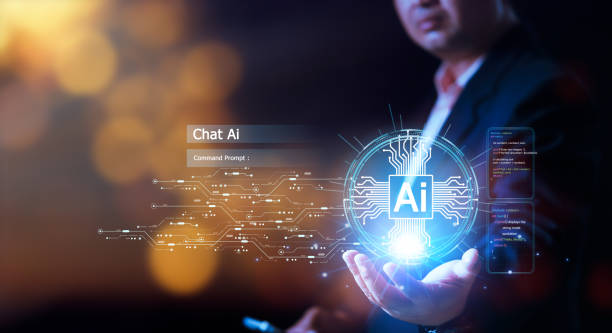What is an AI Robot? Definition, History, and Applications
In today’s world, the term #Artificial_Intelligence (AI) is increasingly heard, and one of its prominent manifestations is the AI robot.
But what exactly is an AI robot? In short, an AI robot refers to a robot that uses artificial intelligence algorithms to perform tasks and interact with its environment.
These robots can collect information through sensors, analyze data, and make decisions based on it.
The history of AI robots goes back decades, when researchers began exploring the possibility of integrating AI and robotics.
Today, AI robots are used in a wide range of industries, including manufacturing, healthcare, customer service, and even entertainment.
AI robots have the ability to perform repetitive, dangerous, or complex tasks that are difficult or impossible for humans.
To better understand AI robots, one must pay attention to their main components.
These components include sensors, processors, actuators, and artificial intelligence software.
Sensors collect information from the environment, processors analyze data, actuators enable the robot to move and perform actions, and AI software enables decision-making and learning.
AI robots, using these components, can perform various tasks, including facial recognition, autonomous navigation, and human interaction.
AI robots are rapidly developing and are expected to play a more significant role in our lives.
While the potential of AI robots is vast, it is important to also consider the challenges and ethical considerations associated with them.
Are you tired of your e-commerce site having visitors but no sales? Rasaw with professional e-commerce website design solves your main problem!
✅ Significant sales increase with targeted design
✅ Seamless user experience for your customers
⚡ Get a free consultation!
Types of AI Robots: From Industrial Robots to Virtual Assistants
The world of AI robots is very diverse, and there are various types of robots with different capabilities and applications.
One common categorization is based on the robots’ application.
Industrial robots are designed to perform specific tasks in manufacturing environments.
These robots are usually very precise and fast and can perform repetitive tasks continuously.
#Cobots, or collaborative robots, are a type of industrial robot designed to work alongside humans.
Service robots are designed to provide services to humans in various environments.
These robots can perform tasks such as cleaning, delivering goods, or providing information.
Virtual assistants are a type of service robot that interacts with humans through voice or text.
Virtual assistants can answer questions, perform tasks, and provide information.
Military robots are designed for use in military operations.
These robots can perform tasks such as reconnaissance, bomb disposal, and combat.
Space robots are designed for use in space environments.
These robots can perform tasks such as satellite repair, planetary exploration, and building space bases.
In addition to categorization by application, robots can also be categorized by their level of artificial intelligence.
Simple robots can only perform pre-programmed tasks.
More complex robots can learn and adapt to new situations.
Intelligent robots can make decisions and solve problems.
Choosing the right type of AI robot depends on the specific needs and requirements of each application.
Click here to preview your posts with PRO themes ››
Main Components of an AI Robot
An AI robot consists of several main components that work together to enable the performance of various tasks.
These components include #sensors, processors, actuators, and artificial intelligence software.
Sensors collect information from the surrounding environment.
This information can include visual, auditory, tactile data, and more.
Processors analyze the data collected by sensors and decide what the robot should do.
Actuators enable the robot to move and perform actions.
These actuators can include motors, pumps, and so on.
Artificial intelligence software enables decision-making and learning.
These software programs can use various algorithms such as machine learning, neural networks, and so on.
The interaction between these components allows the AI robot to interact with its environment and perform various tasks.
For example, an AI robot can use visual sensors to detect objects, use processors to decide how to react to these objects, and use actuators to move its arms to pick up objects.
The development of AI robots requires a deep understanding of how these components work and how they interact with each other.
| Component | Description | Examples |
|---|---|---|
| Sensors | Collecting information from the environment | Camera, microphone, touch sensors |
| Processors | Analyzing data and making decisions | CPU, GPU |
| Actuators | Movement and action | Motors, pumps |
| AI Software | Decision-making and learning | Machine learning algorithms, neural networks |
Machine Learning and Its Role in AI Robot Development
#Machine_Learning (ML) plays a very important role in the development of AI robots.
Machine learning allows robots to learn from data and improve their performance without explicit programming.
Machine learning algorithms enable robots to recognize patterns in data, make predictions, and make decisions.
For example, an AI robot can use machine learning to learn how to recognize objects, how to navigate in a complex environment, or how to interact with humans.
There are different types of machine learning algorithms, each suitable for specific tasks.
Supervised learning uses labeled data to train the robot.
Unsupervised learning uses unlabeled data to train the robot.
Reinforcement learning uses feedback to train the robot.
The choice of the appropriate machine learning algorithm depends on the type of data and the task the robot needs to perform.
Machine learning enables AI robots to become more flexible, adaptable, and intelligent.
This has led to the development of AI robots with more advanced capabilities and wider applications.
Do you dream of a thriving online store but don’t know where to start?
Rasaw is your comprehensive e-commerce website design solution.
✅ Attractive and user-friendly design
✅ Increased sales and revenue⚡ Get a free consultation
Applications of AI Robots in Various Industries
AI robots have extensive applications in various industries and are increasingly reshaping how tasks are performed.
In the manufacturing industry, AI robots are used to perform repetitive, dangerous, or precise tasks.
These robots can help increase productivity, reduce costs, and improve quality.
In the healthcare industry, AI robots are used to perform tasks such as surgery, rehabilitation, and patient care.
These robots can help improve accuracy, reduce pain, and accelerate the recovery process.
In the customer service industry, AI robots are used to answer customer questions, provide support, and solve problems.
These robots can help improve customer satisfaction, reduce costs, and provide 24/7 service.
In the logistics industry, AI robots are used for warehousing, transportation, and delivery of goods.
These robots can help increase speed, reduce costs, and improve accuracy.
AI robots are constantly evolving, and their applications are expected to expand across various industries.
This will lead to increased productivity, reduced costs, and improved quality.
Challenges and Limitations of AI Robots
While AI robots have great potential, they also face challenges and limitations that need to be addressed.
One of the main challenges is the high cost of developing and deploying AI robots.
These robots require significant investment in research and development, hardware, and software.
Another challenge is the complexity of programming and controlling AI robots.
These robots require complex algorithms and large amounts of data to learn and function correctly.
Also, AI robots may encounter problems and not perform optimally when faced with unexpected and complex situations.
Ethical considerations are also an important challenge in the development of AI robots.
Issues such as accountability, privacy, and discrimination must be carefully considered.
Furthermore, there are concerns about the impact of AI robots on employment and the economy.
As technology advances, some jobs may be replaced by AI robots.
To address these challenges, we need investment in training and skill development, the creation of appropriate policies, and attention to ethical considerations.
What Will Be the Future of AI Robots?
The future of AI robots is very exciting and full of potential.
With technological advancements, AI robots are expected to become smarter, more flexible, and more adaptable.
This will lead to the development of AI robots with more advanced capabilities and wider applications.
In the future, we can expect AI robots to play a more significant role in our daily lives.
These robots can help us with various tasks, including caring for the elderly, educating children, and providing medical services.
Also, AI robots can help solve major global problems, including climate change, hunger, and disease.
However, to realize this potential, we must also address the challenges and ethical considerations associated with AI robots.
We must ensure that AI robots are developed and used responsibly and with human interests in mind.
| Trend | Description | Impact |
|---|---|---|
| Increased Processing Power | More powerful hardware enables the execution of more complex algorithms. | AI robots will be able to perform more complex tasks and make more precise decisions. |
| Advancements in Machine Learning Algorithms | Newer algorithms enable faster and more efficient learning. | AI robots can adapt to new environments more quickly and improve their performance. |
| Improved Sensors | More accurate and sensitive sensors collect more precise information from the environment. | AI robots will have a better understanding of their surroundings and can make better decisions. |
| Increased Human-Robot Interaction | New interaction methods facilitate easier communication between humans and AI robots. | AI robots can collaborate more effectively with humans and respond to their needs. |
Ethical Considerations in the Development and Use of AI Robots
The development and use of AI robots require attention to ethical considerations.
Issues such as accountability, privacy, and discrimination must be carefully examined.
Accountability means that it must be determined who is responsible for the performance of the AI robot.
If an AI robot causes harm, who will be held accountable? Privacy means that AI robots should not collect or use individuals’ personal information without their consent.
Discrimination means that AI robots should not treat individuals unfairly based on race, gender, or other factors.
To ensure the ethical development and use of AI robots, we need to establish ethical and legal frameworks.
These frameworks must be continuously reviewed and updated to adapt to technological advancements.
Additionally, necessary training on AI robot ethics should be provided to developers, users, and the general public.
Did you know that poor online store design can drive away up to 70% of your potential customers? Rasaweb transforms your sales with professional and user-friendly e-commerce website designs.
✅ Significant increase in sales and revenue
✅ Full optimization for search engines and mobile
⚡ [Get a free consultation from Rasaweb]
How to Build an AI Robot?
Building an AI robot can be a challenging but very exciting project.
To begin, you need a basic understanding of robotics, programming, and artificial intelligence.
The main steps in building an AI robot include defining the goal, designing, constructing, programming, and testing.
In the goal definition phase, you must specify what your robot should do.
This helps you choose the right components and plan your work.
In the design phase, you must outline the overall design of your robot.
This includes choosing the type of robot, its size, shape, and components.
In the construction phase, you must assemble the components of your robot.
In the programming phase, you must write the necessary software to control your robot.
This includes programming sensors, processors, and actuators.
In the testing phase, you must test your robot and ensure it works correctly.
Building an AI robot requires patience, perseverance, and continuous learning.
However, the final result can be very rewarding and allows you to get closely acquainted with this fascinating technology.
Learning Resources for AI Robots
Various resources are available for learning about AI robots.
These resources include books, online courses, websites, and online forums.
Books can be an excellent resource for learning the basics of AI robots.
Online courses can be a great way to learn practical skills in the field of AI robots.
Websites can provide up-to-date information and news related to AI robots.
Online forums can be a great place to connect with other AI robot enthusiasts and exchange information.
Some well-known resources for learning about AI robots include #Coursera, #Udemy, #edX, and the #Robotics_Association.
By using these resources, you can acquire the knowledge and skills necessary to enter the world of AI robots.
Frequently Asked Questions
| Question | Answer |
|---|---|
| What is an AI robot? | An Artificial Intelligence Robot (AI Robot) is a machine capable of understanding its environment, reasoning, learning, and making decisions to perform tasks autonomously. |
| What is the difference between regular robots and AI robots? | Regular robots perform repetitive tasks based on prior programming, while AI robots can learn from experience, interact dynamically with the environment, and even behave in a way that resembles human intelligence. |
| What are the main applications of AI robots? | They are used in industries (manufacturing, assembly), medicine (surgery, diagnosis), services (customer support, domestic), exploration (space, underwater), and many other fields. |
| What technologies are used in building AI robots? | Machine Learning, Computer Vision, Natural Language Processing, Deep Learning, and Robotics are among the key technologies. |
| Can AI robots have emotions? | Currently, robots do not have emotions in the human sense. They can identify and react to emotions, but they do not experience emotions themselves. |
| What are the main challenges in developing AI robots? | Safety, reliability, ethics, autonomy, adaptability to complex environments, and natural human interaction are important challenges. |
| How are AI robots trained? | They are usually trained using large amounts of data, machine learning algorithms, and deep learning to identify patterns and make decisions. |
| Examples of AI robots in daily life? | Smart robotic vacuum cleaners, customer support chatbots, self-driving cars, and surgical robots in hospitals. |
| Are AI robots a threat to human jobs? | Some repetitive jobs may become automated, but at the same time, robots can increase productivity and create new jobs in the development, maintenance, and supervision of these systems. |
| How is the future of AI robots predicted? | They are expected to become smarter, more autonomous, and capable of performing more complex tasks, and interact more closely with humans in various environments. |
And other services of Rasaweb Advertising Agency in the field of advertising
- Smart Marketing Automation: A professional solution for online growth with a focus on custom programming.
- Smart Advertising Campaign: A creative platform for improving customer acquisition with Google Ads management.
- Smart Customer Journey Map: A creative platform for improving campaign management with marketing automation.
- Smart Sales Automation: A new service for increasing click-through rates through Google Ads management.
- Smart Advertising Campaign: A fast and efficient solution for digital branding with a focus on attractive UI design.
And hundreds of other services in the field of internet advertising, advertising consultation, and organizational solutions
Internet Advertising | Advertising Strategy | Advertorials
Resources
- Digiato – Smart Robot Articles
- Zoomit – AI Robot News
- ISNA – Future of Smart Robots
- IRNA – Review of Latest Robotic Achievements
? With “Rasaweb Afarin”, your business takes flight in the digital world! From fast and creative website design to comprehensive online marketing strategies, we are your digital success partner.
📍 Tehran, Mirdamad Street, next to Bank Markazi, Kazeroun Jonoubi Alley, Ramin Alley, No. 6

